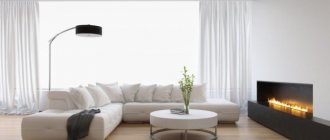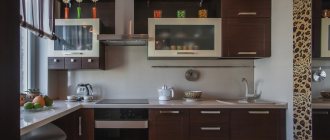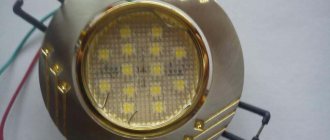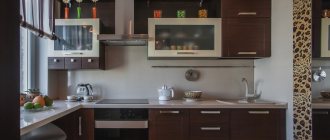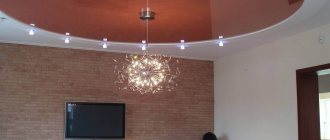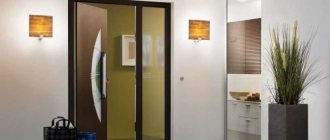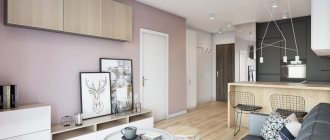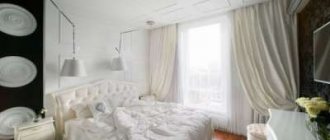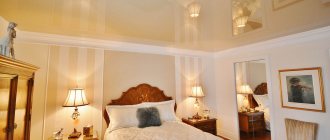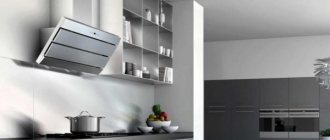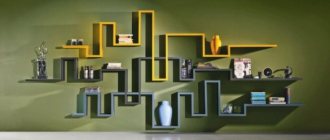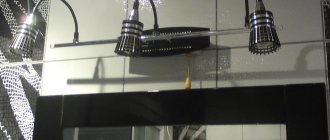Spotlights (another name is spots) have become a characteristic detail of modern rooms. Sometimes they are used to organize main or background lighting, sometimes their role is to provide detail, to draw attention to the front of a cabinet or a picture on the wall. Spot lighting in the interior is a great opportunity to make rooms stylish and cozy.
Location of lamps around the perimeter Source cms.giadinhtre.vn
Device features and benefits of use
Spotlights got their name due to the small size of the lamp and the external effect of radiation from a single point.
The lamp is enclosed in a shade; hence the main feature of the spots: the light dispersion angle does not exceed 30°, and the light flux itself has the shape of a cone. A small angle allows you to illuminate a limited part of the space, so for uniform lighting, use a group of spots with a fairly dense arrangement.
The steady demand for spot lighting is explained by the following benefits of use:
- Spots are practically invisible and therefore adapt to any interior. Small ceiling lamps are hidden under the surface when installed and therefore do not burden the space.
- You can choose spots for any style. Some models allow you to adjust the direction of the light, which increases their design capabilities.
- You can evenly illuminate any room. A chandelier does not always cope with this task, but well-placed spots on the ceiling will easily solve the problem.
- You can organize partial lighting of the room, and thereby significantly save electricity.
Using outdoor spots
Street spots are used to illuminate the area near the house. They have great power and range of luminescence, and will also help in creating decorative effects when lighting a certain area of the yard. Street lamps are made of glass and metal in white, black, gray and other colors.
They allow you to adjust the direction of light and also have protection from the negative effects of precipitation, so street spots are the best option for lighting your personal plot.
Types of spotlights
If we talk about appearance, then, in addition to round ones, there are models of square, oval and non-standard shapes. It is convenient to classify spotlights according to the place of attachment:
- Built-in. Such lighting fixtures decorate suspended and suspended ceilings, walls and stairs. They require lamps with a minimum heating level so as not to damage the base.
- Invoices (external). There are wall and ceiling; the structure is fixed with screws, the light flow is distributed by the diffuser of the outer housing.
- Furniture. Mortise and overlay spot models help illuminate furniture fronts, work surfaces, as well as the interior space of shelves and drawers.
- Hanging. Such spotlights take up more space in the interior, since installation is carried out on special mounts, and the device remains visible. Many hanging models are equipped with a rotating mechanism.
Built-in ceiling models, in turn, differ in the type of installation:
- Models for installation in rigid suspended structures (plasterboard, plastic panels, slatted ceilings); equipped with two fastening clips.
- Models for suspended ceilings. In this case, installation is carried out using special brackets before the canvas is tensioned.
What are lighting spots?
The main advantage is the ease of placement on walls and ceilings.
The lamps can be rotated, which will help illuminate the desired object and highlight important details in the room. Spots can be either a single light source or part of a lighting composition. The lamps do not put pressure on vision - they have a comfortable brightness for the eyes.
Kinds:
- Built-in – installed in a suspended ceiling.
- Overhead – attached to a special bracket that is installed on the ceiling.
- Combined - there are two or more sources in the housing that can be independently directed.
Based on the light source, there are classic and LED spots. Installing spots does not require knowledge or skills, it is only important to follow safety precautions. Spots are universal devices that are suitable for large and small apartments.
Types of lamps:
- LED;
- halogen;
- incandescent lamps.
Choose the right material. Most often, metal or thermoplastic is used to create spots. If the spot will be used as an additional lighting device, it is better to choose a material made from temperature-resistant plastics. For spots that are used as the main light source, it is advisable to install metal structures.
How many spots are needed and how to place them
To determine the optimal number of spotlights (if you mean main lighting), there is a special formula, but the calculation can be done in a simpler way. To do this, the following calculations are carried out:
- The total number of watts per room is determined. The area of the room is multiplied by the number of Watts required by lighting standards per 1 m2. According to SNIP, the lighting level for a bedroom is 12 W/m2, for a nursery - 15 W/m2, for a living room - 20 W/m2.
- To determine the minimum number of lamps, the total number of Watts is divided by the power of the selected lamp.
Inverse problem: to determine the power of one lamp, the total number of Watts is divided by the number of lamps.
Spotlights are installed taking into account the following conditions:
- The distance to the wall must be at least 70 cm.
- To determine the distance between lamps, the length of the wall is divided by the number of spots.
- To determine the distance of the lamps from the wall, half the length of the wall is divided by 2.
Advantages and disadvantages
Positive and negative qualities of products that will help you understand whether this lighting method is beneficial.
Advantages
- Due to their compactness, they fit perfectly into the design of any room in an apartment or house.
- Can be used both as main and additional lighting.
- They allow you to achieve zoning of space and provide light to individual areas.
- By using spotlights with LEDs or halogen bulbs, energy costs are reduced.
- This type of lighting is characterized by an unlimited choice of installation locations. The products can decorate any area, niche, arch, etc.
Due to models with spectacular decor, it is possible to advantageously emphasize the style of the interior.
Lamps with warm or cool shades can create a comfortable atmosphere in the room and give the design a certain mood, depending on individual preferences.
Flaws
- Surface-mounted and recessed lighting fixtures have some installation difficulties and require a professionally designed installation diagram.
- For products with 12 Volt light bulbs, the purchase of a special step-down transformer is required.
- Some types of light sources require a ceiling with a special design.
Scope of application and choice of location
Ceiling lamps in the interior have a wide range of design possibilities, including the following methods of use:
- Arrangement of light accents. The spots beautifully illuminate the multi-level ceiling, furniture, paintings, steps of the stairs, and the pool.
Accents on opposite walls Source gastronomiayviajes.com
- Zoning of space. It is convenient to highlight, for example, the dining area in the living room with light. The device can be installed above a sofa or armchair.
Selecting a working surface Source extremesurvival.info
- Imitation of the starry sky.
- Possibility of dimming (smooth brightness adjustment). Creates an atmospheric (solemn or intimate) atmosphere depending on the time of day or mood.
In the nursery Source pinterest.com
In different rooms, spotlights are used in different ways:
- Living room. Spots are used functionally: as local lighting or instead of a chandelier. In the first case, they are placed around the perimeter of the room, in the second, they are distributed evenly along the ceiling, in rows or in a circle.
Main light source Source m.yukle.mobi
- Bedroom. In a room intended for relaxation, bright, flooding light is useless. Therefore, white spots with frosted glass are installed here.
Comfortable environment Source laceainarie.com
- Kitchen. You can’t do without high-quality lighting here. In addition to stationary ones, it is a good idea to install lamps with a rotating mechanism in the kitchen, perhaps a pair model.
In a white kitchen Source ankaramutfakdekor.com
- Entrance hall (corridor). In a modest-sized room, spotlights do an excellent job as the main light source. They are mounted in one or two rows along the ceiling.
In a square corridor Source mblx.ru
- Bathroom. For wet rooms, choose waterproof models that are safe to use.
Spotlights in the bathroom Source santeh777.ru
Ceiling options
The placement of spotlights needs to be thought out in advance, especially if a suspended ceiling is to be installed.
The backlight can be located either symmetrically or in a chaotic manner.
Light sources built into a multi-level suspended or suspended ceiling will allow you to create a unique interior, highlight the architecture and atmosphere of the room.
The lighting will be uniform and of the highest quality if the devices are installed so that the rays of the light flux intersect above all elements in the room.
The best option is built-in spotlights along the perimeter of the ceiling plane. They can be switched on together with a central chandelier to create more intense lighting.
The parallel arrangement of lamps in several rows will help to achieve proper comfort in the room.
A cross-shaped arrangement of light sources will fit perfectly into a small room with a low ceiling. The corner space is equipped with single models, and a gimbal structure is installed in the center.
Also, for a small room, the arrangement of lamps in the form of a square is appropriate.
In order to illuminate a certain area, an arc-shaped arrangement of lighting fixtures is used. Thanks to this technique, it is possible to soften the strict interior.
Some rooms require the installation of light sources in a checkerboard pattern. For example, a similar solution is often found in the design of an island-type kitchen, where good lighting of all zones is required.
What types of spots are there?
Products are classified by type of fastening. There are the following types of spots.
Ceiling spots
They become a complement to central lighting or completely replace it. The advantage of ceiling products is that it provides the ability to change the direction of the reflector. Thanks to this, you can focus on different interior details, highlight a work area or a place to relax. These lamps have small dimensions, so they are suitable for rooms with low ceilings.
The photo shows the design of a small kitchen with a ceiling equipped with black spotlights.
Wall spots
Such models can be excellent decorative lighting for hanging shelves or wall paintings. Placing the spots above a desk or computer desk will not take up much space and will completely replace a table lamp. Wall-mounted products are also sometimes used as a night light, the main thing is to choose the right power.
The photo shows wall spots located above the TV area in the living room interior.
Built-in
Built-in structures are known to many as adjustable spotlights. In this case, the direction of the light can be slightly changed. Built-in spot spots are used to illuminate small functional areas. To achieve uniform illumination, you can slightly adjust the light flow.
The dimensions of the spot devices are small, and installation requires only making a small hole in the suspended ceiling. Ceiling recessed luminaires are installed using spring clamps.
Invoices
Overhead rotary structures differ from built-in lamps only in the installation method. According to the installation method, they most closely resemble sconces. A special bracket is used to secure them. It is attached to the ceiling, and a lamp is attached to it using screws.
Their advantage is that there is no need to cut a hole in the ceiling. This will allow you to change designs to others at any time.
Complexly combined
The devices differ from spot ones only in that one housing can contain several light sources that can be directed independently. Such designs are most similar to chandeliers. Their main advantage is the ability to effectively illuminate all rooms and direct streams of light even to remote corners of the room.
In addition to the above types, spots are divided according to the shape of the base. There are spots on a bar, as well as designs on a square, round or flat base.
Spots with bracket mounting
It is a very popular type of mount, which allows for free change of light direction. Products may have one or more reflectors. The open mount has different shapes, thereby creating a complete structure that looks quite impressive.
Spots with pole mounting
This model is equipped with several lamps arranged in one straight or curved line. Certain products have a flexible rod that can take on any configuration. With the help of such fastening, the devices are used as original lighting for niches or walls. The design can also act as central lighting for a small room.
The photo shows ceiling spots on a square-shaped rod in the interior.
Photos in the interior of the rooms
Features of installing lamps in the interior of specific premises.
Spotlights in the kitchen
The kitchen space requires a lot of light. It is advisable to install several devices with a bright and soft light flux. In this way, you will learn how to create enough lighting in the kitchen and at the same time achieve a pleasant environment.
If there is not enough free space, you can equip the kitchen wall cabinets with lighting.
Spot lighting in the kitchen in combination with an LED strip of different colors will add even more originality to the design.
Spotlights in the living room interior
In the interior of a living room with a ceiling chandelier, it is better to install light sources with low power. Thus, when the chandelier is turned off, a pleasant, soft and muted glow will emanate from the lamps
. In this case, point devices can be placed only on one side of the ceiling.
For a hall without a central chandelier, almost any arrangement of light sources is suitable, for example, in the form of a circle, square, oval or even a diamond.
Examples in the interior of the corridor
Typically, the design of a hallway assumes the most simple arrangement of lighting fixtures. For a narrow corridor, one row of 3 or 5 point lamps is suitable. In a square room, it is appropriate to install two rows consisting of 3 or 4 light bulbs.
Spot lighting in the bedroom
Perimeter lighting will look great here. A good solution is to install a multi-level stretch ceiling, decorated with dim lighting.
LED strip mounted on the sides of the ceiling plane will complement spotlights advantageously.
Thanks to light sources, the bedroom can additionally be divided into an area with a bed, dressing table or wardrobe.
General recommendations
When organizing light in any room of your home, it is important to consider the following nuances:
- Functional purpose of the room.
- Features of natural lighting, location of windows relative to the sun.
- Room style.
- The need for additional decor and equipment.
For example, when organizing lighting in a bedroom, it is important to consider that this room is intended for rest and sleep, which means the lighting should be soft and comfortable. Lighting in a children's room should be comfortable, and most importantly safe, because children live here who need not only to relax, but also to play and learn homework.
As for the living room, here they watch TV, read, gather at the dining table and receive guests, which means the issue of lighting is especially acute. If the room is large, then a central chandelier is not enough; it is important to use spotlights. Lighting also helps to zone the space, and table lamps and floor lamps will create comfortable conditions for watching TV or reading a book.
Light sources in spotlights
Various types of lamps can be installed in these lighting devices. Manufacturers' products include incandescent, halogen and fluorescent light sources. All of these devices have certain pros and cons. But the best option is LED ceiling spotlights.
They have several obvious advantages that set them apart from other light sources.
LEDs:
- have maximum light output;
- use electrical energy economically;
- create uniform light;
- have the longest service life.
These devices have another important advantage. The LED recessed ceiling lamp can be installed in tension systems without fear for the integrity of the canvas.
During operation, these light sources practically do not emit heat and do not have a negative impact on the structure of the polyvinyl chloride coating.
How does a spot differ from a sconce?
Many people confuse wall spots and sconces. Some models are really visually similar. And they are most often placed in the same place - near the bed or sofa.
However, the products have a significant difference - the method of inclusion. The sconces are equipped with their own switches in the form of a cord or a button on the body. Spots do not have this option. The devices are activated using a general switch or control panel if the house has a “smart light” system.
And one more difference. It is advisable to use spots for organizing general lighting, sconces - not. Devices from the second category are usually used to highlight a small area in a room with light.
Determining optimal power
Determining the required power depends on several factors:
- purpose of the system;
- room area;
- ceiling height;
- lamp parameters.
The use of recessed or overhead spotlights for ceilings as the main lighting requires calculations according to general rules. On average, a 35W light source is installed per 2m2 of area. If this is additional lighting, the indicators of the ceiling chandelier are subtracted from the total power.
When creating comfort in a certain area, the fundamental calculation criterion is its area.
The number of light sources required depends on the type and power of the lamps. Halogen, traditional, LED recessed spotlights have different parameters.
Many models are designed to accommodate any type of lamp.
Basic rules for selecting point models
A large assortment of built-in and surface-mounted spotlights can create certain difficulties when choosing. If it is necessary to install these devices in suspended, tension systems, it is necessary to decide on the type and quantity in advance. Wiring for these light sources will be mounted under the ceiling covering; appropriate holes must be made in the ceiling coverings.
When choosing recessed and overhead spotlights for the ceiling, you must focus on the following criteria:
- purpose of the point light system;
- required power;
- interior style.
Spotlights serve as main lighting
These light sources can serve as main lighting. In this case, you should accurately determine the power and select the location of the lamps that provides high-quality lighting for the entire room. Often these lighting devices are additional and are mounted along with the ceiling chandelier. With such operation, less power of devices is required, and there will be no need to install many light sources. Using spot devices, only a certain area can be illuminated.
Installation of spotlights together with a ceiling chandelier
In the photo of spotlights on the ceiling, you can choose the appropriate product design. In the modern range of models, it is easy to find successful options for any style. Cases and diffusers differ in design and decor. You can choose discreet, laconic lamps, original products with complex designs.
Lamp arrangement
All spotlights have a similar design, including:
- mounting base;
- housing with diffuser;
- Light source;
- connecting cable.
The model range of these lighting products includes various modifications with more complex designs and additional devices. Built-in and overhead ceiling spotlights can be adjusted by remote devices. There are models with an extended lighting angle, equipped with dimming that corrects the illumination.
Lamps differ in the level of protection from dust and moisture, which determines the scope of their intended use.
Installation of spotlights
The question of how to install a spotlight is of interest to many craftsmen who are doing this for the first time. There is nothing complicated in this work.
The main thing is to decide on the installation method and carry out all the work as carefully and accurately as possible.
It is worth noting that, depending on the installation method, a distinction is made between recessed and surface-mounted lamps.
Let's take a closer look at both types:
- Built-in. When installing such spotlights, a hole is made in the canvas. The lamp is installed in such a way that part of its body protrudes outward, that is, it turns out to be built into the ceiling surface.
Such lamps are used on frameless bases, such as a brick wall or a concrete ceiling.
- Surface- mounted spotlights are used exclusively for suspended ceilings. Their level is always below the ceiling level.
When choosing spotlights, you must take into account the method of mounting them - this will allow you to avoid annoying mistakes. Installation of overhead lamps requires the presence of a frame.
In turn, recessed lamps can be divided into two groups depending on their purpose. They can be for suspended or suspended ceilings.
The configuration of spotlights directly depends on their type. Thus, the standard design of a surface-mounted luminaire consists of a special housing equipped with a diffuser and a fastening part.
A recessed lamp consists of fasteners and clamps for lamps built into a special housing.
Installation of such lamps is extremely simple; even a beginner can cope with this task.
Installation of ceiling spots
Fastening technologies for different spots differ, but the general principles of installation are similar.
Installation of ceiling spots consists of several stages:
- Before installing the ceiling structure, a wire is laid from the junction box to the lighting fixture.
- The connection is made in parallel: from the connection device to the first device, and then to subsequent ones.
- When installing an electrical cable, it is worth taking its quantity with a margin of 26-35 cm. The excess wire will then be hidden under the ceiling structure.
- After the ceilings are installed, the fixtures are installed.
- Modern spots require the presence of step-down transformers that are connected to each device.
- When choosing lamps, you need to take into account the size of the product and the dimensions of the room. The choice of option is influenced by the height of the ceilings. The installation site must be freely accessible.
Adjustment type
All of the above types of spotlights can also differ in the type of adjustment. Depending on this, spotlights are:
- non-rotating – illuminate part of the room, but the direction of the light flow cannot be adjusted;
- rotating - allow you to adjust the angle of incidence of light and its direction;
- rotating and retractable spotlights are used to change lighting zones.
In terms of functional features, spotlights can also vary significantly.
Modern models are equipped with remote control, have a wider angle of light incidence, protection against dust and moisture, and other functions.
Smart lighting system
The smart lighting system allows you to turn off and turn on ceiling spots in response to the presence of a person in the room.
The lighting works depending on whether there is a person in the room or not. A motion sensor is mounted at the entrance, which ensures that the lamps turn on. There are other sensors located inside the room that confirm the presence of a person. They don't let the lights go off.
Such designs are complemented by devices for manual control.
Lamps for spotlights
The characteristics of spot lighting indicate that absolutely any lamps are suitable for them - incandescent, halogen, LED.
The choice of lamp type does not in any way depend on what type of lamps is selected.
Let's look at which lamps are better:
- LED lamps have a long service life - up to 5 years. They are economical in terms of electrical consumption, and their light is pleasing to the eye.
- Halogen lamps do not heat up, which is very important for suspended ceilings (especially film ones). The light from them is quite bright, but does not irritate the eyes. The service life of such lamps is decent - up to 4 thousand hours.
- Incandescent lamps have a lower cost compared to halogen and LED lamps. And this, perhaps, is perhaps their only advantage. Incandescent lamps get very hot, so they are rarely used for lamps such as spotlights.
Looking at photos of spotlights in various interiors, we can conclude that with proper and thoughtful placement, this type of lighting is an ideal option for almost any room.
Thanks to them, not only good, proper lighting is obtained, but also a stylish interior design.
In addition, spotlights are universal, because they will fit perfectly into any style, and the soft light will make the room warm and cozy.
Types of lamps for ceiling spots
Wall-ceiling spots can be equipped with various types of lighting elements. Depending on this indicator, the properties of the equipment differ.
Halogen lamps
Such lighting elements visually resemble classic incandescent lamps, but their characteristics are much better than conventional lamps. Their light is much brighter and is not inferior to the sun. In addition, their use makes it possible to highlight certain interior objects.
Halogen lamps are durable, energy efficient and have a high brightness rating. However, due to the fact that such light bulbs also heat up, it is prohibited to use them for suspended ceilings.
LEDs
LED lamp is the most modern and energy-efficient type of lighting elements. This is why ceiling LED spots are most often used. There are many options for diode spots. A single LED or many small elements can be installed.
Directional LED light is more suitable for illuminating a specific decorative item, but it is preferable to use multiple elements for general lighting of the room.
Diode spots are economical, reliable and durable. LED lighting elements do not heat up, so they can be used for suspended ceilings. You can buy lamps with white and yellow light, as well as different brightnesses. In addition, you can use a brightness adjustment system, so it is possible not only to direct the light through the use of suspended structures with LED lighting, but also to adjust its brightness.
Incandescent lamps
While classic chandeliers still use incandescent lamps, most modern lighting fixtures use energy-saving lighting elements. In addition, the use of incandescent lamps in spots is not recommended for a number of reasons:
- Spots with light bulbs require a reflector that will reflect both light and heat. In addition, hanging spots are most often made of plastic, which is damaged by constant heating. In this case, it is recommended to use glass structures, the cost of which is higher.
- Modern technologies are aimed at maximum energy efficiency, so diode spots are most often produced, which allow you to get even lighting and save energy.
- Incandescent lamps have a warm light. To create certain design options, the ability to vary shades is important, and incandescent lamps do not provide this opportunity.
- The heat generated by incandescent lamps can damage some surfaces. For example, it is prohibited to use such lamps for suspended ceilings. With prolonged contact, they can damage even plastic structures.
How to calculate the number of lamps
Before choosing a suitable arrangement of lamps, you need to calculate the required number. It should be calculated based on the standards. These standards vary significantly for different premises.
In non-residential premises, the light should not be as bright as in residential rooms. Current standards can be found in the relevant SNiPs.
The number of ceiling lighting fixtures is calculated as follows:
- You need to multiply the area of the room by the light standard according to the standard from the table above. The result will be the total lighting power (example: 16 m? * 150 = 2400 Lux).
- Next, determine the power of the lighting sources and their types. You should know their luminous flux (let's say this value is 200).
- Then the total power must be divided by the power of one lamp. This way you can calculate the number of lamps (2400:200Lx=12 pcs).
It happens that the standards specified in SNiPs imply too bright light. But sometimes you really want softer lighting. This must be taken into account when choosing methods for lighting the ceiling with spotlights.
It's better to do everything so that you can have different options. For this purpose, lighting devices are divided into groups.
If there are two groups, then they are connected through one to the line, and then connected to a switch with two keys. The first row of lamps on the ceiling can be the main one, the second - secondary. Then you can turn on the light bulbs one at a time, and as a result the glow will be either dim or very bright.
If necessary, the lamps can be divided into a larger number of groups, output them separately to different switches and turn on as needed.
Minimum distance
When determining the location of lamps, it is important to know that lamps can become very hot and affect the surrounding area. Therefore, it is not recommended to place lamps too close to the walls; the optimal distance from the outermost row of lamps to the wall is 20 cm.
If the height of the room is no higher than 2.5 m, then there should be a distance of at least 30 cm between the rows of devices.
Light zoning
The principles of zoning in the living room provide for the need to highlight any object that you would like to emphasize in the overall interior of the room. This could be a coffee or coffee table, an armchair, a chair, shelves near the TV, etc. Thus, objects or entire areas in functional areas will be better illuminated, and the surrounding space with all its contents will be darkened. This technique will help you place accents at the right points, but they will have to be foreseen at the design stage.
Options for suspended ceilings
There are no secrets when it comes to lighting suspended ceilings. It is important to choose the right lamps. The lamps are positioned similarly to ceilings made of plasterboard structures. You need to select lamps based on the ceiling material.
For example, you should not use traditional incandescent lamps together with PVC film - they are too hot, modern fabric allows lamps less than 60 W, but no more.
If there is no central lighting in the room, then the installation of more powerful lamps with the ability to rotate will be required. You can get harmonious lighting by choosing a tone.
To be able to adjust the brightness, experts advise installing a dimmer. It is an adjustable device - you can create a dim, pleasant light or a bright glow.
Above or at ceiling level
This category includes lamps for suspended ceilings. Their peculiarity is that the glow is emitted directly from the ceiling. It looks very, very impressive. However, there are disadvantages. Thus, the efficiency of the light is not fully utilized; a significant part of the glow will fall above the level of the ceiling structure.
Due to the fact that there is no flow of fresh air between the base and suspended ceilings, the lamp and luminaire heat up. It is better to use LED lamps, they do not heat up to high temperatures.
Below ceiling level
These below-ceiling solutions feature maximum dispersion. But there are problems with power and current. So, the light bulb has a power limit of less than 35 W. The voltage is below 220 V, which means a transformer must be used.
Other options
You can also highlight overhead lamps. Installing them is more difficult - you need to prepare the ceiling surface. But there is much more choice. The advantage of such models is that they can accommodate light bulbs of any type.
More about spot lighting
Depending on the design idea, lighting on the ceiling will allow you to distribute light sources throughout the room as much as possible, highlight important areas, and hide individual parts in the room. It is important to understand that using traditional light sources you will not be able to get point light. They use special lamps for the ceiling - they are low-power, otherwise called spots.
A system based on spotlights can be installed either in suspended or suspended ceilings. This can be a structure in the form of a multi-level ceiling made of plasterboard, MDF, or aluminum panels. These lamps look great in a plastic ceiling.
In the case of modern ceiling structures, hanging a traditional chandelier is not the right approach. External light is becoming a thing of the past. New, internal spot light is in fashion.
Key Features
The main feature of any spotlights is the small angle of light dispersion. So, the angle is 30 degrees. Only a small part of the room is illuminated. Considering this fact, the arrangement of lamps should be very dense. Another feature is that the light flux has a conical shape.
To ensure uniform and, most importantly, high-quality lighting, it is necessary to place the lamps so that the cones of the light flux intersect at a level above all objects in the room.
Advantages and disadvantages
This type of lighting has both pros and cons, but first let’s highlight the main advantages:
- Spot light makes it possible to only partially illuminate a particular room. Many people only need lighting for a few objects. Unnecessary areas should not be illuminated.
- Lamps can be placed in any part of the room and thereby obtain the most illuminated room. Often powerful chandeliers are not the best way to illuminate remote corners and places.
- Another important advantage is the complete absence of shadow. At any point in the room, flow is created directly overhead, which significantly reduces shadows. At the same time, light is also supplied from other parts of the room.
- Cost-effectiveness can also be highlighted. One ceiling light uses less electricity to operate than large chandeliers that illuminate the entire room.
- A spotlight scatters light streams at small angles, making it possible to illuminate objects from below. This is very beneficial in terms of design. The quality of light is much higher - it is brighter.
- Compared to a traditional chandelier, the service life of spotlights is longer, which allows you to save money on their purchase.
- Often, to organize such a solution, it is necessary to supply a current with a voltage of 12 V. This increases safety several times and also saves resources.
- With the help of these lamps you can get a multi-colored glow - this allows you to play and try new things. This enhances the beauty of the interior.
- These systems are much cheaper in terms of the cost of lighting fixtures. You can’t buy a large and powerful chandelier for this money.
Spot lighting is beautiful, safe and economical
Now about the disadvantages, of course, this is far from ideal despite all the advantages:
- There are certain difficulties in the process of designing and organizing lighting. The system consists of a large number of devices, so creating a project will require larger investments than developing general lighting systems.
- Some types of lighting fixtures may require a special ceiling design, such as a suspended ceiling, which is not suitable for small rooms with a low ceiling level.
- If you plan to install 12 V lamps, then they will need transformers or separate power supplies.
If you have a low ceiling, then it is better to avoid this type of lighting.
Unusual ideas for placing lamps
Quite unconventional methods of installing and placing lamps in rooms are often used. In addition to the general light, they create a starry sky effect - it looks amazing.
There are a lot of different ideas, but you need to choose them wisely. The golden rule is that these ideas must be combined with the interior.
You can illuminate the picture, place lamps in a plasterboard structure at the head of the bed. Sometimes they make multi-level light. All this looks very impressive.
Is it possible to repair spots?
You can change the lamps yourself, observing safety precautions. Ceiling spots are convenient, easy to install, multifunctional and modern lighting devices with the ability to rotate. They come in different sizes, shapes, styles, and ways to use them in the interior. Properly designed lighting will allow spots to become the main source of light in the room or highlight important areas. Will highlight her uniqueness and individuality.
How to choose
An important criterion when choosing lamps in the interior is their design, which is consistent with the style of the room. For a classic room, you can choose models with ornaments or crystal pendants. In a room with a modern design (modern, high-tech, loft) standard white lamps of a simple shape are suitable.
In addition to the appearance and material of the lampshade (it can be glass or acrylic), when choosing, pay attention to the following details:
- Design. If the ability to change the angle of light is important, pay attention to rotating lamps.
- Base type (usually GU10 or LED).
- Dust and moisture protection class. Important when installing in a bathroom, open veranda or kitchen.
- Possibility of changing the type of lamp (LED instead of halogen).
- Possibility of connecting a dimmer.
How to choose spots for the interior of the room
Thanks to the wide variety of ceiling spotlights and their versatility, they can decorate absolutely any interior. The style of the room and its color design are two criteria that you should focus on when selecting spots for the interior.
- If you need to organize spot lighting in a room designed in a classic style, choose rounded lines and imitation of precious metals.
- In interiors made in modern styles, such as modern, high-tech, loft and others, square and rectangular spots with glass and metal elements are appropriate.
- For suspended and suspended white ceilings in rooms of any style, spots of the same color would be a universal option.
Ceiling spots have become a part of our lives. And if once upon a time their appearance in an apartment was rather a fashionable trend, today spots solve many problems. They act both as additional light sources and are used instead of classic chandeliers, play a decorative role in the room, placing accents and highlighting a certain area, and are able to visually adjust the dimensions of the space. In addition, spots are economical, convenient, durable and easy to install. A competent choice of spots will make your home not only stylish and modern, but will also eliminate the need to replace light sources for a long time.
